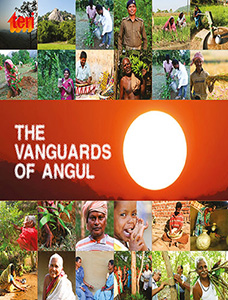The Last Frontier: people and forests in Mizoram
- Author(s): Daman Singh
- Size: 140 mm × 210 mm
- Pages: 324
- Binding: Paperback
- Weight: 350 gms
- Language: English
- ISBN: 9788185419176
- Cover Price:
Rs.450.00 / US $29.00
- Special Price: Rs. 405.00 / US $27.00
Book Details
The last frontier: people and forests in Mizoram details the relationship between the people and their environment, and between the environment and development. It is set in Mizoram, one of the seven states of the ecologically complex north-eastern region, a land where society and culture present a fascinating blend of tradition and modernity whose history and polity varies from that of most other parts of India. The book traces the environmental history of Mizoram, beginning in the nineteenth century, through colonial rule and into the post-Independence period. It examines the nature of biophysical resources and the influence of human activities on them. Finally, the management of forests by people and the state is analysed, including a detailed discussion on the system of shifting cultivation.
Table of Contents
- Settlement in the Lushai hills
- The supremacy of the village chief
- Forests: abode of the spirits
- Shifting cultivation or jhum
- The influence of people on their environment
- Parameters of resource use
- Compulsions for conquest
- Economic importance of the Lushai Hills
- Instruments of insulation
- The system of administration
- The new socio-religious order
- Ecological implications of political events
- State control over forests
- The system of commercial extraction of forest produce
- Revenue from forests
- The traders’ lobby
- Game versus vermin
- The continuance of shifting cultivation
- New farming methods
- The drift of public policy
- The route to self rule
- A limited taste of freedom
- The struggle for Independence
- From Union Territory to State
- Isolation, alienation, and regionalism
- Public participation in governance
- Legitimizing shifting cultivation
- Forests for the people
- Implications for resource use
- Religion
- Education
- Community relations
- Growth and distribution of population
- Occupational mobility
- Urbanization
- Land use policies
- Geomorphology
- Land forms
- Climate
- Soils
- Types of vegetation cover
- Land use
- The extent of forests
- Basic characteristics
- The quality of forest resources
- The wood and bamboo balance
- The existence of village forest reserves
- Norms governing village forests
- Changes in area of village forests
- Availability of forest produce
- Control by the village council
- Imperatives of local management
- Forests in the hands of the State
- The incidence of encroachment
- Regulating commercial use of forests
- Afforestation programmes
- Imperatives of governmental management
- The element of collectivity
- Community management of shifting cultivation
- Preferred sites for j humming
- Allotment of jhum plots
- Clearing the forest
- Burning
- Sowing
- Weeding
- Harvesting
- The element of uncertainty
- The village scenario
- The dependence on shifting cultivation
- The duration of jhum cycles
- Levels of productivity
- The post-jhum ecosystem
- Effect on biodiversity
- Climatic change due to deforestation
- Floods in the plains
- The role of fire -
- Soil erosion and run-off
- Sustainability of productivity
- Myth, conjecture, and reality
- A review of past strategies
- The old New Land Use Policy
- The Jhum Control Project
- Changes in the New Land Use Policy
- The alternative to shifting cultivation
- Reserved tree species in the Lushai Hills
- Domestic animals killed by wild animals in the North Lushai Hills as reported by village writers
- The Lushai Hills District (Jhumming) Regulation, 1954
- The Mizo District (Forest) Act, 1954
- Socio-economic data of Mizoram
- Agricultural statistics
- Distribution of slope categories for select river catchments
- Physical characteristics of soils in Mizoram
- Tree species found in major forest types
- Nature of slopes used in shifting cultivation
- Percentage shares of land use categories in Mizoram
- General characteristics of vegetation cover in Mizoram
- Vegetation cover by strata
- Growing stock per hectare by strata
- Percentage distribution of stems per hectare by diameter class
- Major species contributing to basal area in each stratum
- Wood and bamboo consumption
- The existence of village forest reserves
- Changes in the extent of village forest reserves
- Availability of trees and bamboos for domestic use
- Detection of offences committed in safety and supply reserves
- Revenue from forests
- Carrying capacity of land under shifting cultivation: Mampui and Sairep village (1962)
- Jhum cycles in Mizoram
- Shifting cultivation in sample villages
- Pattern of secondary succession after jhumming at Burnihat
- Soil and water losses due to shifting cultivation
- Farming systems research by ICAR RCNEHR (Shillong) at Burnihat: 1976-89
- Rice production in Mizoram
- Promising crops for cultivation in the north-eastern region
- The location of Mizoram and the north-eastern region in India
- Territories occupied by Mizo tribes before the British rule
- The location of places mentioned in chapter 2 and chapter 3
- Mizoram: geology
- Mizoram: rivers
- Mizoram: soil nutrient status
- Mizoram: forest reserves
- Revenue obtained from the hill areas of Eastern Bengal and Assam, 1903-04
- Receipts from forests of the Lushai hills district (in rupees, annas, paise)
- Number of wild animals killed for which rewards were paid: 1943-44 to 1947-48
- Percentage of literacy by sea
- Percentage distribution of total main workers * (approximate estimate based on 1991 census)
- Area under different categories of slope
- The pattern of land use in Mizoram (1987-89)
- Average soil loss and affected area (estimated for five catchments)
- Extent of vegetation cover in Mizoram (1975-76)
- Land use and land cover by thematic mapping (1989)
- District-wise extent of forest (1987-89)
- The extent of forests by different sources
- The extent of vegetation cover by type
- Growing stock of trees and bamboo by strata
- Species diversity of strataThe legal status of forest
- Family labour involved in clearing forest
- Gross village income by source in Hmunpui (1964-65)
- Output-input ratios of cultivation
- Early succession at Burnihat and Sesawng
- Coverage of the New Land Use Policy
List of figures
List of tables
Foreword by Dr T N Khoshoo
Preface
Introduction: The last frontier
Part I: An environmental history of Mizoram
Chapter 1: The regime of village republics
Chapter 2: British occupation of the Lushai Hills
Chapter 3: Forests and fields: colonial land use policy
Chapter 4: The creation of Mizoram
Chapter 5: The roots of environmental change
Part II: Management of resources: between people and the State
Chapter 6: Physiography, land cover, and land use
Chapter 7: Forests, their form and features
Chapter 8: Keepers of the forest
Chapter 9: How shifting cultivation works
Chapter 10: The tenacity of shifting cultivation
Chapter 11: The environmental impact of shifting cultivation
Chapter 12: The new land use policy
Conclusion: People and forests in Mizoram
Appendices
References
Index
List of figures
List of tables
Keywords
You may also like...
-
 The Vanguards of Angul: People and forests
Regular Price 400.00
Special Price 360.00
The Vanguards of Angul: People and forests
Regular Price 400.00
Special Price 360.00
-
 Nagaland is changing
Regular Price 400.00
Special Price 360.00
Nagaland is changing
Regular Price 400.00
Special Price 360.00
-
 Back To The Roots
Regular Price 400.00
Special Price 360.00
Back To The Roots
Regular Price 400.00
Special Price 360.00
-
 TERRAVIEW - Rural Resources (English)
Regular Price 400.00
Special Price 360.00
TERRAVIEW - Rural Resources (English)
Regular Price 400.00
Special Price 360.00

-
The book traces the environmental history of Mizoram, beginning in the 19th century, through colonial rule and into the post-Independence period.
Forests, Trees and People Newsletter No.34 -
'For so useful and well produced a work, on a neglected area and theme, both the author and publisher deserve praise'
Economic and Political Weekly 9 August 1997
